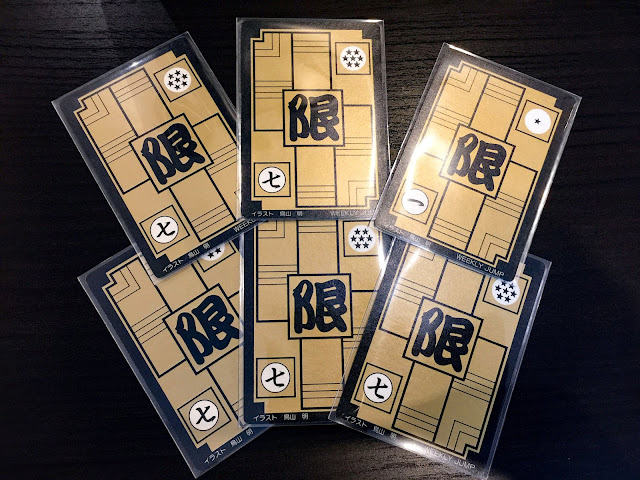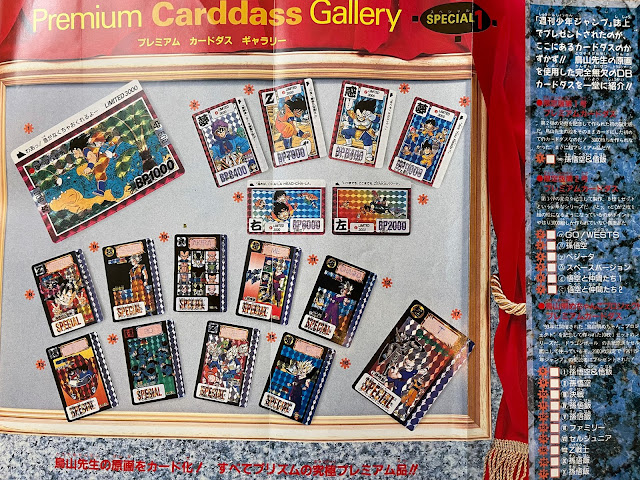 |
| The Mechanko Project HK edition Carddass cards |
From 1993 to 1994 Bandai Japan decided to print another set based on the Toriyama Akira Mechanko Project Carddass cards. Originally planned for Hong Kong and other non Japanese Asian markets, this set made use of the 6 illustrations that were chosen a few months earlier for the Visual Adventure Special part metallic cards (or laser cards as some call them).
These cards were given in pairs accompanying the sale and
orders of white boxes (the retailer sealed containers that carried the
cards) of re released Carddass parts to retailers. There were a total of three sets of pairs for this series, for a total of 6 prisms. The three pairs were
cards number 1 & 2 in late 1993, then in 1994 cards number 3 & 4, and lastly cards
number 5 & 6 later that same year.
For more detailed information on the cards and texts, please read about the Mechanko Project versions of these cards here.
 |
| Part 1 includes the "Son Goku" (written in gold) and the "Son Gohan" cards |
Normally the cards in white boxes were intended to be sold in vending machines, but often times vendors would also put them in card albums to sell them individually. This practice was most common in smaller Japanese boutiques, as well as being a popular practice in anime and manga goods stores in various countries including France. A lot of children who grew up with Dragon Ball Carddass will remember hunting down such stores in order to be able to buy their favorite prisms (or even multiple copies of them) without having to use vending machines.
These Special Carddass cards despite not being distributed in Japan were still made in Japan (with all texts in Japanese). They were near identical to the Mechanko cards, with a few differences: the card numbers were changed putting them in a different order, and the scouter boxes no longer had the “Toriyama Akira Mechanko Project” puzzle letters, instead having a more classical "Special" in its place.
Veteran collectors will notice two additional differences: the white level and saturation levels of the colors are somewhat different to the Mechanko Project cards (with white levels here reproduced closer to how the older Carddass parts were made).
 |
| Part 2 includes the "Son Gohan" (this time written in gold) and the "Z Fighters" cards |
Despite being manufactured for distribution in non Japanese Asian countries, all three parts of the Carddass Special cards found their way into the French market in fairly large quantities. Presumably through anime and manga goods shop that had connections to Hong Kong. They also found their way (in smaller quantities) back to Japan. This may be partly responsible for the diminished frequency of the third part in the local Hong Kong markets (some collectors believe it received a smaller print, but this is unconfirmed). In Japan the second part appears to be the easiest to find. In France they all appear to be of equal rarity according to local collectors, while in Hong Kong the first set is more common, and the third set much rarer.
 |
| Part 3 includes the "Decisive Battle" and the "Family" cards |
They have become harder to come by over the years, but in comparison to the rarest limited cards such as the Limited 3000 cards or the Mechanko Project cards, the Special Carddass cards are still reasonably accessible to committed collectors. They are usually comparable to the Over 1 Billion Carddass Commemoration limited 6000 prisms in terms of their pricing. The number of cards circulated is unknown but some reasonable estimates put it at under 10 000. For all we know it could be as rare as the limited 6000 prisms, and the minor price difference could be explained to there being slightly less demand.
The selection Bandai made here is outstanding in my opinion. The set contains several of my favorite Mechanko Project cards (in particular the "Son Gohan" cards, the cell centered "Decisive battle" card, and the "Z fighters" card). The way the white reproduction comes through gives these cards a slightly vintage quality, setting them a little closer to the Limited 3000 cards in that respect. I think even fans who have the Mechanko Project cards should consider obtaining a set of these as well as they are a very beautiful and charming set.
I highly recommend this set to any serious Dragon Ball Carddass collector, assuming the price isn't an obstacle of course. A wonderful selection of special prisms that do great justice to a wonderful arc of Dragon Ball!







































